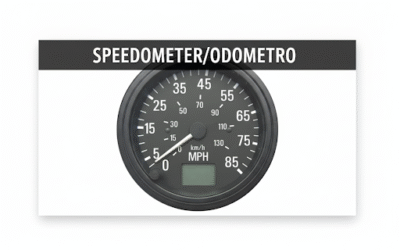
A tachometer measure the RPM of petrol and diesel engines. It takes an input from various signals like ECU / ignition coil / alternator or a magnetic pick up sensor , filters the input and converts it internally to drive a pointer or a digital display to indicate the RPM.
What applications / vehicles does IIL make Tachometers for ?
IIL makes tachometers for use in mobility as well as non mobility based applications. A tachometer can be used anywhere where there is a petrol or diesel engine being used. Mobility applications include on road applications such as specialty cars, hot rods, trucks and buses; off road applications such as farm equipment, tractors and construction equipmemt. The stationary or non mobility applications include generators, compressors and many other applications using IC engines.
Purpose of Tachometers in Vehicles
Tachometers measure speed in revolutions per minute (RPM). These give the user real time RPM of engine while driving the vehicle or operating the equipment. In case of mobility based applications, they can help the driver avoid over-revving, make the proper gear shifts, and preserve fuel efficiencies, hence improving driving performance and extending engine life . In case of race car applications, the driver may want to rev the engine as high as possible and the tachometer helps give him the adrenaline high bby indicating how high the RPM went. In stationary applications, the tachometer is a useful preventive or even predictive maintenance tool, since over-revving trends may indicate clutch or transmission issues.
How Does a Tachometer Work?
There are two kinds of tachometers in terms of input, i.e. mechanically driven and electronically driven tachometers. Mechanical tachometers accept input from the engine thorugh physically rotating flexible cable which is usually mechanically inserted inside the tachometers. This is an old technology, so we wont go into further detail.
Electronic Tachometers in turn can be further divided into two categories, i.e. those which accept analog signals and those which accept digital signals. Analog signals are in the form of frequency coming from the alternator, crankshaft, or ignition system of the engine. This signal is filtered to remove noise , spikes, etc. and after this the frequency is convert into a voltage, which drives the air core movement / stepper motor which in turn move the pointer; or in case of a digital output drive a digital display. Some electronic tachometers accept digital inputs for example a J1939 output . The digital input requires minimal filtering and it too is converted to an analog voltage which drives the pointer / display
What are the types of analog input signals to tachometers?
Tachometers accept analog inputs from following sources :
Alternator
- Inputs are taken from the W terminal which connects to the alternator stator winding.
- The number of pulses per revolution depends on the alternator’s pole count, and also the ratio of the diameters of the alternator pulley and engine pulley
- The accuracy may not be very good if the belt connecting alternator to engine slips.
Ignition Coil
- In spark-ignition engines, the coil primary or secondary circuit provides sharp voltage pulses for each ignition event.
- The tachometer counts these pulses and converts them into engine RPM.
Magnetic Pickup (Mag Pick-up) sensor
- Produces sinusoidal pulses as teeth pass by, directly proportional to RPM.
- This is commonly used in diesel engines where no ignition coil is present.
Frequently Asked Questions (FAQ)
Q1. What distinguishes a speedometer from a tachometer?
A speedometer records a vehicle’s wheel RPM and converts it to speed (km/h), whereas a tachometer measures engine RPM. The wheel RPM and the engine RPM are always different in a vehicle even though the engine drives the wheel, due to the various gears used in the axle, differential , gear box, etc
Q2. Can an hourmeter be integrated into a tachometer?
Yes an hourmeter is often integrated into a tachometer by putting in a digital display, which can be an LCD display or even mechanical figure wheels. The mechanical figure wheels , while being an older and less reliable technology, give the advantage that the hourmeter reading can be seen even without power
Q3. Why do I see a tachometer used in EVs even though there is no IC enginer ?
Even though EVs are not driven by IC engines but sometimes people put a tachometer feature in to monitor the speed of the motors which drive the vehicle. The motors are driven by the batteries in EVs, and so are not as critical to the vehicle as engines are in an IC engine vehicle.
Q4. Why is there no tachometers in 3W running on IC engines ?
Even though tachometers are used with IC engines generally, but three wheelers are very low cost vehicles and are unable to absorb the cost of a tachometer
Q5. How can we calculate Full scale Frequency or pulse per revolution required for a tachometer ?
Full scale Hz = (PRR X Full scale RPM)/60
PRR for mag pick up input = No. of flywheel teeth
PRR for alternator input = (No. of poles X engine pulley diameter ) / (2 X alternator pulley diameter)
PRR for ignition coil driven = number of cylinders / 2
Q6. what is the advantage of Stepper Motor driven vs. Air-Core driven Tachometers?
Stepper motor-driven tachometers use a small motor controlled by digital pulses, usually from a microcontroller. This design allows for very high accuracy (within about 2%) and enables self-test functions like full-scale sweep at startup. However, they tend to be slightly slower in response and are generally higher in cost due to the added electronics.
Air-core tachometers, on the other hand, use electromagnetic deflection to move the pointer directly. They offer almost instantaneous needle response, moderate accuracy (within about 4%), and are relatively lower in cost. They have long life spans, though accuracy may decline slightly over time, and they lack built-in self-test features.





